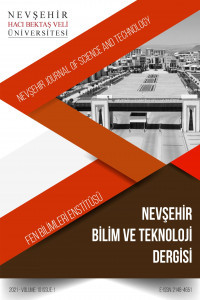Fenton ve Fotofenton Prosesleri ile Atıksudaki Aspirinin Giderim Verimliliğinin Karşılaştırılması
Aspirin, Fenton prosesleri, İleri oksidasyon prosesleri, KOI, TOK
Comparison of Removal Efficiency of Aspirin in Wastewater by Fenton and Photo-Fenton Processes
Aspirin, Fenton processes, Advanced oxidation process, COD, TOC,
___
- Bouzenno H., Hfaiedh N., Giroux-Metges M., Elfeki A., Talarmin H., “Biological properties of citral and its potential protective effects against cytotoxicity caused by aspirin in the IEC-6 cells” Biomedicine & Pharmacotheraphy, 87, 653- 660, 2017.
- Deminiat B., Razavipanah I., Rounaghi G. H., Arab-Zavar M. H., “A novel electrochemical imprinted sensor for acetylsalicyclic acid based on polyprole, sol-gel and SiO2@Au core-shell nanoparticles” Sensor and Actuaters B, 244, 785-795, 2017.
- Kummerer K., “Pharmaceuticals in the environment” Springer, 527s, USA, 2004.
- Heberer T., “Occurance fate and effects of pharmaceutical residues on the aquatic environment: A review of recent research data” Toxicology Letters, 131 (1/2), 5-17, 2002.
- Yunlong L., Wenshan G., Huu H. N., Long D. N., Faisal T.H., Jian Z., Shang L, Xiaocheng C. W., “A review on the occurence of micropollutants in the aquatic environment and their fate and removal during wastewater treatment, Science of the Total Environment, 4734-4740, 619-641, 2014.
- Liu W., Wang Y., Zhang L., “Hydrothermal synthesis of FeS2 as a high effiency fenton reagent to degrade alachlor via superoxide-mediated Fe (II)/ Fe(III) cycle, ACS Applied Materials&Interfaces, 7, 28534-28544, 2015.
- Sonmez G., “İleri oksidasyon prosesleri ile bazı ilaç kalıntılarının giderimi” Aksaray Üniversitesi, Fen Bilimleri Enstitüsü, Doktora Tezi, 97s, Aksaray, 2015.
- Anipsitakis G. P., Dionysiou D. D., “Transition metal/UV based advanced oxidation technologies for water decontamination, Applied Catalysis B: Environmental, 54(3), 155-163, 2004.
- Li W., Nanaboina V., Zhou Q., Korshin G. V., “Effects of fenton treatment on the properties of effluent organic matter and their relationship with degradation of pharmaceuticals and personal care products” Water Research, 46, 403-412, 2012.
- Akbal F., Balkaya N., “Toksik organik kirleticilerin gideriminde ileri oksidasyon teknolojileri, Yıldız Teknik Üniversitesi Dergisi, 4, 47-55, 2002.
- http://www.enviolet.com/en/uv-oxidation/uvoxidation/photo-fenton-reaction.html [Erişim Tarihi:3.05.17]
- https://www.astm.org/Standards/D1252.htm [Erişim Tarihi: 3.05.2017]
- Trapido M., Kulik N., Goi A., Veressinina Y., Muntar R., “ Fenton treatment efficacy for the purification of different kinds of wastewater” Water Science and Technology, 60(7), 1795-1801, 2009.
- Tekin H., Bilkay O., Ataberk S. S., Balta T. H., Ceribasi I. H., Sanin F. D., Dilek F. B., Yetis U., “Use of fenton oxidation to improve the biodegradability of a pharmaceutical wastewater” Journal of Hazardous Materials B, 136, 258-265, 2006.
- Ustun Odabasi S., Maryam B., Buyukgungor H., “Assessment and investigation of paracetamol from wastewater by using oxidation process and TOC” 3rd International on Recycling and Reuse, 28-30 Eylül, Full paper book, 161s, İstanbul, 2016.
- Ustun Odabasi S., Buyukgungor H., “Investigation and evaluation of degradability of ibuprofen from wastewater by using fenton process” EJENS- European Journal of Engineering And Natural Sciences, 2(1), 114-119, 2017.
- Kang Y. W., Hwang K., “Effect of reaction conditions on the oxidation efficiency in the fenton process” Water Research, 10, 2786-2790, 2000.
- ISSN: 2148-466X
- Yayın Aralığı: Yılda 2 Sayı
- Başlangıç: 2012
- Yayıncı: Nevşehir Hacı Bektaş Veli Üniversitesi
Hasan Hüseyin DERTLİ, Fezayil SUNCA, Mehmet AKKÖSE
Bazı İlaç Kalıntılarının US ve US/H2O2 Prosesleri ile Giderimi
Şakir ERDOĞDU, Ufuk KANDİL, Memduh NAS, Şirin KURBETCİ, Safa NAYIR
Tekstil Endüstrisi Atıksularının Arıtımında Kullanılan Proseslerin Araştırılması
Bazalt Fiberle Güçlendirilmiş Doygun Silt Zeminin Mekanik Davranışının Deneysel İncelemesi
Cyrille Prosper NDEPETE, Sedat SERT
MOF-5 Bağlı Karışık Matriksli Membranların Sentezi, Karakterizasyonu ve Gaz Ayırma Özellikleri
Hülya AYKAÇ ÖZEN, Bahtiyar ÖZTÜRK, Hamdi ÖBEKCAN
Muhammed Azim EIRGASH, Vedat TOĞAN, Aynur KAZAZ
Sulardan Humik Asit Gideriminde Demir Kaplı Zeolitle (DKZ) Katalitik Ozonlama
Çevresel Su Örneklerinde GC/MSD ile Pestisit Analizi ve Metot Validasyonu
Fenton ve Fotofenton Prosesleri ile Atıksudaki Aspirinin Giderim Verimliliğinin Karşılaştırılması
